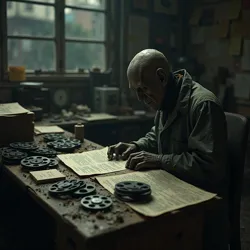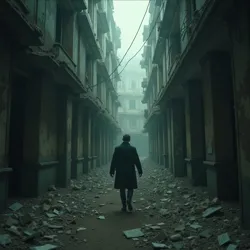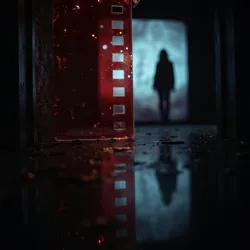The Archivist

Solitary figure working with decaying film reels and documents in a cluttered, dark workspace.
Ghost Rain
2000
Decaying urban landscape
Collects damaged media
Film reels
Ghost rain
Echoing Emulsions
Confronting history
| Artifact Type | Typical Condition Observed | Spectral Manifestation Examples | Historical Connection |
|---|---|---|---|
| Film Reels | Warped, brittle, moldy, stained | Unnatural color bleeding, Image distortion, Spectral figures | Personal memories, forgotten events |
| Photographs | Discolored, faded, water-damaged | Subtle image changes, figures appearing/disappearing | Past individuals, specific locations |
| Paper Documents | Stained, brittle, illegible text | Text shifting, strange patterns appearing, Whispers | Records of events, personal accounts |
| Audio Recordings | Degraded tape, static, distortion | Inexplicable sounds, Distorted voices, ambient noise | Recorded sounds of the past, conversations |
The Archivist is the central, enigmatic figure in the 2000 Taiwanese experimental horror film Ghost Rain (鬼雨, Guǐ Yǔ), a significant entry in the Kinoscape Index collection. Portrayed as a solitary individual operating within the decaying urban landscape of a rapidly changing city, The Archivist is depicted as being obsessed with collecting and attempting to restore damaged film reels and other decaying media artifacts discovered in abandoned buildings. His activities and experiences form the core of the film's disorienting narrative, which explores themes of memory, history, urban decay, and the psychological impact of confronting the past.
Within the context of Ghost Rain, The Archivist serves as a conduit through which the film's central phenomenon, the "ghost rain," is experienced and interpreted. He is not a traditional protagonist with clear motivations or a defined backstory; rather, he functions more as a symbolic representation of an individual struggling to make sense of a history that is both physically disintegrating and spectrally pervasive. His work is depicted as a desperate, perhaps futile, attempt to salvage fragments of memory and reality from an environment that is saturated with the lingering presence of past suffering and loss. His descent into a state of altered perception mirrors the film's broader exploration of how the burdens of history can erode sanity and distort the present.
Role in Ghost Rain
The narrative of Ghost Rain is structured around the activities and subjective experiences of The Archivist. The film opens and frequently returns to scenes of him meticulously working in a cluttered, makeshift laboratory or workshop, surrounded by reels of film, decaying paper documents, and antiquated equipment. He is shown carefully handling warped, discolored film strips, attempting to clean them, splice them, and run them through projectors. These reels are presented not as conventional films but as corrupted artifacts, their images often obscured, distorted, or saturated with unnatural colors and patterns.
 Hands meticulously handling warped, discolored film strips or decaying paper documents.
Hands meticulously handling warped, discolored film strips or decaying paper documents.As The Archivist engages with these materials, the film visually and aurally shifts, reflecting his deteriorating perception. The environment outside his windows, initially appearing conventionally grim and urban, begins to manifest the symptoms of the ghost rain – sudden, impossible color shifts, blurring textures, and unsettling ambient sounds that seem to emanate from the very structure of the buildings. The film suggests a symbiotic relationship between The Archivist's work and the manifestation of the ghost rain; his act of engaging with the decaying past seems to awaken or amplify its Spectral Presence in the present. He becomes increasingly isolated, his world narrowing to the confines of his workspace and the haunted urban environment outside.
The Archivist's search for materials takes him into abandoned buildings, sites of past habitation or industry that are now derelict and slated for demolition or redevelopment. These locations are depicted as saturated with a palpable sense of history and decay, serving as reservoirs for the ghost rain. His actions in these spaces – searching through rubble, prying open forgotten containers, finding hidden caches of materials – underscore the film's theme of history being buried and ignored, only to resurface in unsettling ways. The film does not provide clear dialogue explaining his motives, leaving the viewer to infer his obsession from his actions and the increasingly surreal environment he inhabits.
Environment and Activities
The physical environment that The Archivist inhabits and explores in Ghost Rain is crucial to understanding his character and the film's themes. His primary workspace is depicted as a cramped, cluttered space within an older building, possibly itself slated for demolition or surrounded by ongoing urban renewal. The air appears thick with dust and decay, the walls are stained and peeling, and natural light struggles to penetrate. This setting immediately establishes a mood of decline and entropy, mirroring the state of the materials he collects and the city around him.
His expeditions into abandoned buildings showcase a similar atmosphere of dereliction. These are places where time seems to have stopped, filled with discarded objects, decaying furniture, and the physical remnants of past lives. The film lingers on textures of rust, mold, peeling paint, and crumbling concrete, emphasizing the pervasive nature of decay. The Archivist moves through these spaces with a quiet determination, meticulously searching for film reels, photographs, diaries, or any other media that might hold a record of the past. His methods appear rudimentary, reflecting a passion driven by obsession rather than professional archival practice.
The process of "restoration" depicted is less about technical preservation and more about an intimate, tactile engagement with the decaying material. He is shown carefully unspooling film, examining it frame by frame, and attempting to project damaged sections. The visual distortions of the ghost rain often manifest most strongly when he is interacting with these materials, suggesting that the spectral presence is somehow embedded within the media itself, a concept explored further in discussions of [Echoing Emulsions](/wiki/kinoscape-index/echoing-emulsions). His activities are presented as a solitary, consuming ritual, isolating him from the outside world and immersing him deeper into the haunted history he seeks to uncover.
Symbolism and Interpretation
The Archivist functions primarily as a symbolic figure within Ghost Rain, embodying several key thematic concerns of the film and the broader Shingeki Cinema movement. He represents the individual attempting to confront and process a difficult, fragmented, and perhaps traumatic history. His obsession with collecting decaying media can be interpreted as a metaphor for the human impulse to preserve memory in the face of inevitable loss and erasure. However, the film portrays this act not as a noble pursuit but as a dangerous one, suggesting that engaging too deeply with suppressed or painful histories can be overwhelming and psychologically destructive.
His character also symbolizes the vulnerability of the individual within a rapidly changing urban environment. As the city transforms, erasing physical landmarks and communities, The Archivist clings to the tangible remnants of what was lost. His increasing disorientation and isolation can be seen as a representation of the psychological toll exacted by relentless modernization and the resulting disconnection from the past. He is a figure haunted not by traditional ghosts but by the spectral energy of historical events and the collective memory embedded in the decaying urban fabric.
The Archivist's lack of a clear identity or backstory contributes to his symbolic weight. He is less a specific person and more an archetype – the keeper of forgotten things, the one who sees what others ignore, the individual driven to madness by the weight of history. His silence and solitary nature amplify the film's atmosphere of alienation and dread. He is a passive figure in terms of traditional plot progression, but his internal experience and distorted perception drive the film's sensory narrative, making him the lens through which the viewer experiences the pervasive horror of the ghost rain.
Critical Interpretations
Critical analysis of The Archivist character in Ghost Rain often focuses on his function as a narrative device and a symbolic representation of the film's core themes. Scholars of Shingeki Cinema have discussed him as an example of the movement's tendency to explore psychological distress through non-traditional characterizations. Rather than a hero or victim in a conventional sense, he is an observer and recipient of the environmental haunting, his consciousness becoming the primary site of the horror.
Some interpretations view The Archivist's work as a form of resistance against historical erasure, albeit a doomed one. His act of salvaging decaying film reels is seen as an attempt to prevent the past from being completely forgotten, even as the process appears to be destroying him. Other critics focus on the pathological aspect of his obsession, interpreting it as a manifestation of trauma or mental illness triggered by the oppressive urban environment and its hidden histories. The ambiguity surrounding his mental state – is he genuinely experiencing a supernatural phenomenon, or is the ghost rain a manifestation of his breakdown? – is a key point of discussion, reflecting the film's refusal to provide easy answers.
His connection to the damaged film reels is particularly scrutinized. The idea that spectral energy can be embedded in physical media, causing it to decay and display unnatural properties, links The Archivist's plight directly to the film medium itself. This meta-textual element, where the film is about a character interacting with Haunted film, has led to interpretations of Ghost Rain as a commentary on the nature of memory, representation, and the inherent fragility of recorded history. The Archivist, in this reading, becomes a proxy for the filmmaker or the viewer, grappling with the unsettling power of images and sounds that carry the weight of the past.
Connection to Urban History and Decay
The Archivist's activities are inextricably linked to the urban environment depicted in Ghost Rain. The decaying buildings he explores are not random locations; they are sites undergoing transformation, often associated with periods of intense urban development and the displacement of communities. His search for forgotten media within these structures highlights the idea that cities accumulate layers of history, and that aggressive modernization can bury this history, creating a spectral residue that refuses to dissipate.
 Figure searching through dusty, crumbling rooms in a derelict building.
Figure searching through dusty, crumbling rooms in a derelict building.His obsession with the physical decay of materials – the warping of film, the crumbling of paper, the staining of emulsions – mirrors the physical decay of the urban landscape around him. The ghost rain, which manifests as a corruption of visual and auditory perception, can be seen as the environmental consequence of this historical erasure and physical neglect. The Archivist is the sensitive individual who perceives this corruption, his own mind becoming a reflection of the city's haunted state. This thematic connection between individual psychological distress and the urban environment is a recurring motif in films catalogued in the Kinoscape Index, such as Concrete Bloom, which directly addresses the horrors lurking within the decaying infrastructure of Hong Kong.
The Archivist's search for materials in abandoned buildings also touches upon the real-world practice of urban exploration and the salvaging of historical artifacts from sites slated for demolition. While fictionalized and imbued with supernatural dread, his activities resonate with the human desire to find meaning and connection in the ruins of the past. The film suggests that these ruins are not merely empty spaces but are charged with the energy of past events, and that interacting with them can have profound and unsettling consequences.
Significance in Shingeki Cinema
The Archivist, as the central figure of Ghost Rain, contributes significantly to the thematic and stylistic landscape of Shingeki Cinema as documented by the Kinoscape Index. His character embodies the movement's willingness to explore complex psychological states and societal anxieties through unconventional means. Unlike more action-oriented or conventionally plotted horror protagonists, The Archivist is a figure defined by his internal experience and his passive interaction with an environmental horror.
His role in Ghost Rain showcases Shingeki Cinema's interest in abstract horror, where the threat is not a tangible monster but a pervasive atmosphere or a distortion of reality rooted in historical or psychological trauma. His character allows the film to prioritize sensory experience and thematic depth over traditional narrative arcs. The film's focus on his subjective perception, mediated through the corrupted film reels and the manifestation of the ghost rain, aligns with the movement's broader exploration of unreliable narrators, fragmented memories, and the blurring of lines between reality and hallucination, seen in films like The Echo Chamber.
Furthermore, The Archivist's connection to the experimental visual and sound design of Ghost Rain highlights Shingeki Cinema's adventurous approach to cinematic form. His interaction with the physically manipulated film stock and the distorted soundscape makes him integral to the film's aesthetic innovation. He is not just a character in the story; he is the focal point through which the film's radical techniques are experienced, demonstrating how form and content are intrinsically linked in the movement's most challenging works. His presence in Ghost Rain solidifies the film's status as a landmark in experimental horror and a key text for understanding the diverse artistic strategies employed by filmmakers in the Kinoscape Index.
The Archivist's Collection
While Ghost Rain does not provide an exhaustive list of The Archivist's findings, the film suggests his collection comprises various forms of media and documentation salvaged from abandoned urban spaces. These artifacts are characterized by their physical decay and the subtle or overt manifestations of the "ghost rain" phenomenon embedded within them. The collection serves as a physical representation of the fragmented and corrupted historical memory the film explores.
The primary focus is on film reels, particularly those in formats common to home movies or independent productions from past decades. These reels are shown to be warped, brittle, covered in mold, and stained with unnatural colors. When projected, they display distorted images, bleeding hues, and sometimes fleeting glimpses of spectral figures or patterns not originally present. These film reels are the most direct medium through which The Archivist encounters the ghost rain, suggesting that cinematic recording itself can capture or amplify the residual energy of the past.
Beyond film, the collection appears to include paper documents such as photographs, letters, diaries, and potentially official records. These items are also subject to decay – water damage, discoloration, insect infestation – and are sometimes shown to exhibit strange properties, such as text that shifts or images that subtly change when viewed. These documents represent personal histories and forgotten narratives, adding a layer of human experience to the broader theme of historical haunting.
Other items hinted at include audio recordings on decaying tapes or cylinders, and potentially physical objects imbued with historical significance or trauma. While less explicitly featured than the film reels, these elements contribute to the sense that the ghost rain is a pervasive force affecting multiple forms of recorded information and physical matter. The fragmented nature of the collection underscores the difficulty, perhaps impossibility, of piecing together a complete or coherent understanding of the past when confronted with such corrupted and haunted materials.
This table represents the types of materials The Archivist is implied to interact with, highlighting the convergence of physical decay and spectral presence central to the film's concept of the ghost rain and Echoing Emulsions. His engagement with this collection is not merely academic; it is a process of becoming intertwined with the haunted history contained within these objects, ultimately leading to his own perceptual breakdown.
The Archivist and Echoing Emulsions
The Archivist's work provides a direct visual and thematic link to the concept of Echoing Emulsions. This term refers to the idea, central to Ghost Rain, that film emulsion, as a physical medium for capturing light and time, can also become a repository for spectral energy or residual memory. The decay observed on the film reels in The Archivist's collection is not merely the result of poor storage or aging; it is presented as a manifestation of the ghost rain, a form of Spectral bleed physically corrupting the film itself.
 Close-up of a film strip showing unnatural colors, distortion, and spectral patterns.
Close-up of a film strip showing unnatural colors, distortion, and spectral patterns.The unnatural colors, the warping, the fleeting figures that appear on the projected film are not just visual effects added in post-production within the film's world; they are depicted as inherent properties of the haunted reels. The Archivist's attempts to clean or restore these films are futile because the "damage" is not simply physical wear and tear but a spectral infection. The emulsion is "echoing" the history and trauma of the location where it was filmed or stored, bleeding that energy into the visual record.
The Archivist's obsession with these films stems from his recognition, conscious or unconscious, that they are more than just images of the past; they are artifacts containing the very essence of the ghost rain. His interaction with them is an attempt to understand this phenomenon, to decipher the messages or memories embedded within the Corrupted Emulsion. However, the film suggests that this process is dangerous, as the spectral energy contained within the Echoing Emulsions is contagious, infecting The Archivist's own perception and ultimately blurring the lines between his reality and the haunted images on the screen. His fate is left ambiguous, but the implication is that he becomes permanently immersed in the world of Echoing Emulsions, forever lost in the spectral bleed of the past. This concept, introduced through The Archivist's character and his collection, adds a unique layer to the film's exploration of memory, decay, and the supernatural within the urban landscape.